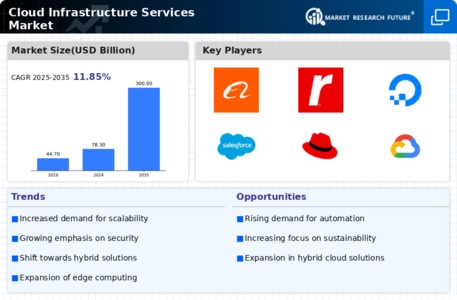The Cloud Infrastructure Services Market is currently characterized by intense competition and rapid innovation, driven by the increasing demand for scalable and flexible IT solutions. Major players such as Amazon Web Services (US), Microsoft Azure (US), and Google Cloud (US) dominate the landscape, each employing distinct strategies to enhance their market positioning. Amazon Web Services (US) continues to focus on expanding its service offerings and enhancing its global infrastructure, while Microsoft Azure (US) emphasizes integration with its existing software ecosystem, thereby appealing to enterprise clients. Google Cloud (US) is carving out a niche through its advanced data analytics and machine learning capabilities, which are increasingly sought after in various sectors. Collectively, these strategies not only intensify competition but also foster an environment ripe for innovation and technological advancement.
In terms of business tactics, companies are increasingly localizing their services to cater to regional demands, optimizing supply chains to enhance efficiency, and investing in sustainable practices. The market structure appears moderately fragmented, with a few dominant players exerting considerable influence. This dynamic allows for both competition and collaboration, as smaller firms often partner with larger entities to leverage their technological advancements and market reach.
In September 2025, Amazon Web Services (US) announced the launch of its new "Green Cloud" initiative, aimed at reducing carbon emissions across its data centers. This strategic move underscores AWS's commitment to sustainability, aligning with global trends towards environmentally responsible practices. By investing in renewable energy sources and enhancing energy efficiency, AWS not only strengthens its brand image but also positions itself favorably in a market increasingly driven by corporate social responsibility.
In August 2025, Microsoft Azure (US) unveiled a partnership with a leading telecommunications provider to enhance its edge computing capabilities. This collaboration is strategically significant as it allows Microsoft to extend its services closer to end-users, thereby improving latency and performance. Such partnerships are indicative of a broader trend where cloud providers seek to integrate their services with telecommunications infrastructure, enhancing their competitive edge in a rapidly evolving digital landscape.
In July 2025, Google Cloud (US) launched a new suite of AI-driven tools designed to optimize cloud resource management for enterprises. This initiative reflects Google’s ongoing commitment to innovation and its focus on providing advanced solutions that meet the complex needs of modern businesses. By leveraging artificial intelligence, Google Cloud aims to differentiate itself in a crowded market, potentially attracting clients looking for cutting-edge technology to enhance operational efficiency.
As of October 2025, the competitive landscape is increasingly shaped by trends such as digitalization, sustainability, and the integration of artificial intelligence. Strategic alliances are becoming more prevalent, as companies recognize the value of collaboration in enhancing service offerings and expanding market reach. Looking ahead, competitive differentiation is likely to evolve from traditional price-based competition towards a focus on innovation, technological advancement, and supply chain reliability. This shift suggests that companies that prioritize these elements will be better positioned to thrive in the dynamic Cloud Infrastructure Services Market.

















Leave a Comment